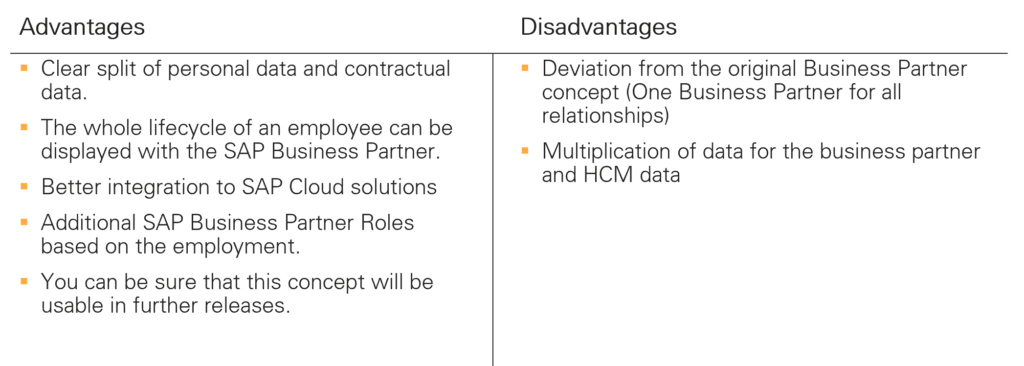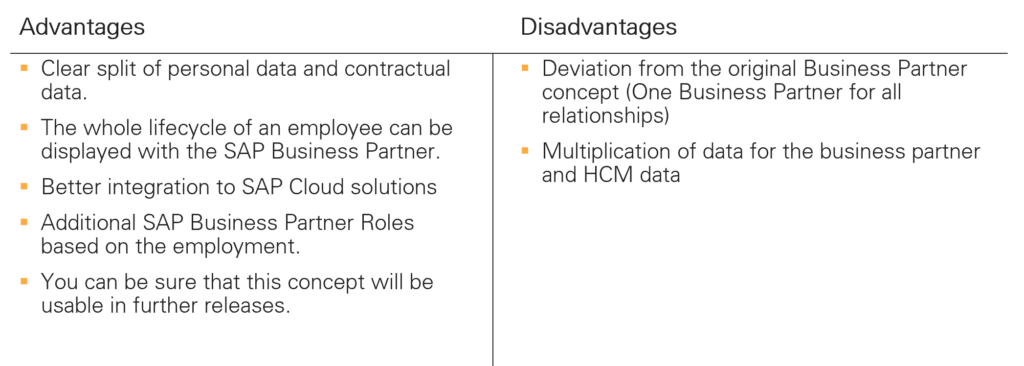Don't forget your employees! The new Employee Business Partner concept
In today's business world, companies face major challenges, especially in human resources management. The heterogeneous system landscapes have grown historically and the cross-system management of employees, their skills and organizational structures is usually mapped decentrally.
SAP S/4HANA 2020 introduces the 'New HCM Business Partner Model', which can be activated by the business function /SHCM/EE_BP_1 and is based on the Central Person Concept from SAP Successfactors. Compared to the previous concept, the 'New HCM Business Partner Model' offers a closer integration of the HCM master record with the business partner and the business user. The integration of the employee with the business partner according to the previous concept includes a lot of information that cannot be mapped via the central business partner. This includes, for example, multiple employments, organizational changes and changes to the business user.

With the 'New HCM Business Partner Model', the employment is separated from the employee and separate business partners are created for the employee and his employments. A new relationship type ensures the connection between the business partner for the occupations and the business partner for the employee.

This new function enables the tracking of historical organizational changes and the central storage of all contractual relationships, which are also traceable in SAP HCM. Hereby, the entire life cycle of an employee can additionally be mapped at the business partner. In particular, the new data model offers the possibility to properly separate personal data (bank data, private address and communication data) and workplace information (workplace, organization-dependent communication data). In addition, the business user (USR21) is linked to the "central person" to follow the concept of SAP cloud applications (e.g. Concur).
Since the activation of the business function /SHCM/EE_BP_1 to use the 'New Business Partner Model' is irreversible, it must be chosen wisely and the decision whether to use the old or new model must be evaluated. SAP recommends moving to the new model, but the old model also has its advantages and strictly follows the Business Partner approach (one Business Partner for one person, organization or group with whom a business relationship exists).
You can find the advantages and disadvantages of the new concept in the comparison below:

As you can see, the New HCM Business Partner Model offers not only advantages but also disadvantages. Before irreversibly activating the business function of the new model, the understanding of both models including their advantages and disadvantages must be discussed with the responsible departments and led to a conscious decision.
We will go into detail about the old model in the next knowledge articles as part of our series on Employee Business Partner to provide you with the knowledge you need to make an active decision here as well.
If you have any questions in advance about Employee Business Partner Integration, we will be happy to answer them for both concepts.
In today's business world, companies face major challenges, especially in human resources management. The heterogeneous system landscapes have grown historically and the cross-system management of employees, their skills and organizational structures is usually mapped decentrally.
SAP S/4HANA 2020 introduces the 'New HCM Business Partner Model', which can be activated by the business function /SHCM/EE_BP_1 and is based on the Central Person Concept from SAP Successfactors. Compared to the previous concept, the 'New HCM Business Partner Model' offers a closer integration of the HCM master record with the business partner and the business user. The integration of the employee with the business partner according to the previous concept includes a lot of information that cannot be mapped via the central business partner. This includes, for example, multiple employments, organizational changes and changes to the business user.

With the 'New HCM Business Partner Model', the employment is separated from the employee and separate business partners are created for the employee and his employments. A new relationship type ensures the connection between the business partner for the occupations and the business partner for the employee.

This new function enables the tracking of historical organizational changes and the central storage of all contractual relationships, which are also traceable in SAP HCM. Hereby, the entire life cycle of an employee can additionally be mapped at the business partner. In particular, the new data model offers the possibility to properly separate personal data (bank data, private address and communication data) and workplace information (workplace, organization-dependent communication data). In addition, the business user (USR21) is linked to the "central person" to follow the concept of SAP cloud applications (e.g. Concur).
Since the activation of the business function /SHCM/EE_BP_1 to use the 'New Business Partner Model' is irreversible, it must be chosen wisely and the decision whether to use the old or new model must be evaluated. SAP recommends moving to the new model, but the old model also has its advantages and strictly follows the Business Partner approach (one Business Partner for one person, organization or group with whom a business relationship exists).
You can find the advantages and disadvantages of the new concept in the comparison below:

As you can see, the New HCM Business Partner Model offers not only advantages but also disadvantages. Before irreversibly activating the business function of the new model, the understanding of both models including their advantages and disadvantages must be discussed with the responsible departments and led to a conscious decision.
We will go into detail about the old model in the next knowledge articles as part of our series on Employee Business Partner to provide you with the knowledge you need to make an active decision here as well.
If you have any questions in advance about Employee Business Partner Integration, we will be happy to answer them for both concepts.
